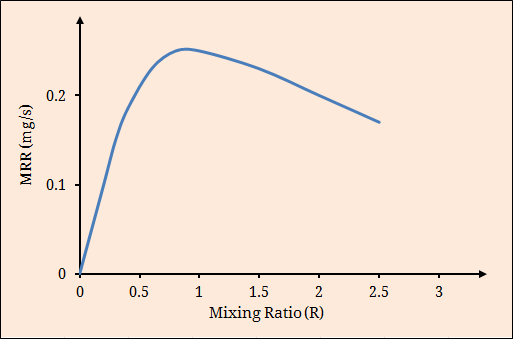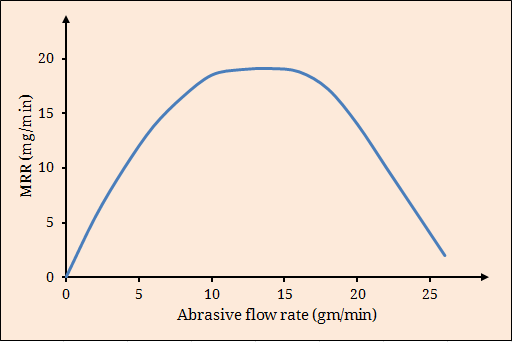In abrasive jet machining (AJM), fine abrasive particles, accelerated by pressurized dehumidified carrier gas are allowed to strike the work surface in the form of a jet with the help of a nozzle. This high velocity abrasive jet gradually erodes material from work surface. Proportion of abrasive grit presents in abrasive jet is one crucial factor as it determines machining performance as well as quality of cut. This proportion is basically identified and defined by a parameter called Mixing Ratio.
What is mixing ratio in abrasive jet machining?
Mixing ratio (M) is defined as the ratio of mass flow rate of abrasive particles to the mass flow rate of carrier gas. Since it is the ratio between two mass flow rates, it is a unitless and dimensionless quantity. It basically determines the concentration of abrasives in the jet. Mathematically, mixing ratio can be expressed as depicted below.

Effects of mixing ratio on material removal rate
When mixing ratio is increased

Mixing ratio can be increased by increasing mass flow rate of abrasive grits maintaining carrier gas flow rate constant. Due to presence of higher number of abrasives in jet, initially increase in mixing ratio causes higher material erosion (thus higher MRR). At the same time it degrades jet velocity because abrasives are accelerated only by the pressurized gas (from the conservation of momentum) and gas pressure is kept constant.
Lower jet velocity indicates less kinetic energy of the jet and hence less energy available for erosion of material from work surface. Therefore, material removal rate (MRR) starts descending with further increase in mixing ratio. So increasing mixing ratio only by increasing abrasive flow rate, keeping gas flow rate constant, ultimately gives lower MRR, which is undesirable. Higher proportion of abrasives may also choke the pipeline, which may even result a burst.
When mixing ratio is kept constant

Material removal rate can be improved by proportionally increasing both the abrasive flow rate and gas flow rate at same rate maintaining mixing ratio constant, as depicted below. In such case, higher pressure of the carrier gas has to be utilized. This necessitates thicker and stronger pipelines and other accessories to smoothly handle such high pressure without leakage and rupture. Since every set-up has limited capability as per its rating, so gas pressure can be increased only up to certain predefined maximum value. Indefinite increase in MRR is not practically feasible.
Effects of mixing ratio on accuracy of cut
Mixing ratio also affects cut quality. When the jet abounds in abrasives, the machining zone fills up with excessive used grits, which restrict free flow of jet by haphazard and repeated collision resulting spreading of jet. Eventually surface quality and tolerance of machined profile degrade. An optimum mixing ratio provides better result in terms of surface quality and tolerance.
References
- Paper: N. Ramachandran and N. Ramakrishnan (1993); A review of abrasive jet machining; Journal of Materials Processing Technology; Vol. 39; pp. 21-31.
- Book: Nonconventional Machining by P. K. Mishra (Narosa Publishing House).
- Book: Nontraditional Manufacturing Processes by G. F. Benedict (Manufacturing Engineering and Materials Processing-19).
- Book: Unconventional Machining Processes by T. Jagadeesha (I. K. International Publishing House Pvt. Ltd.).